
DOWN BUT NOT OUT
Loss of firms, jobs vexes central Toledo business districts
Toledo is not alone in coping with downtown woes
6/22/2008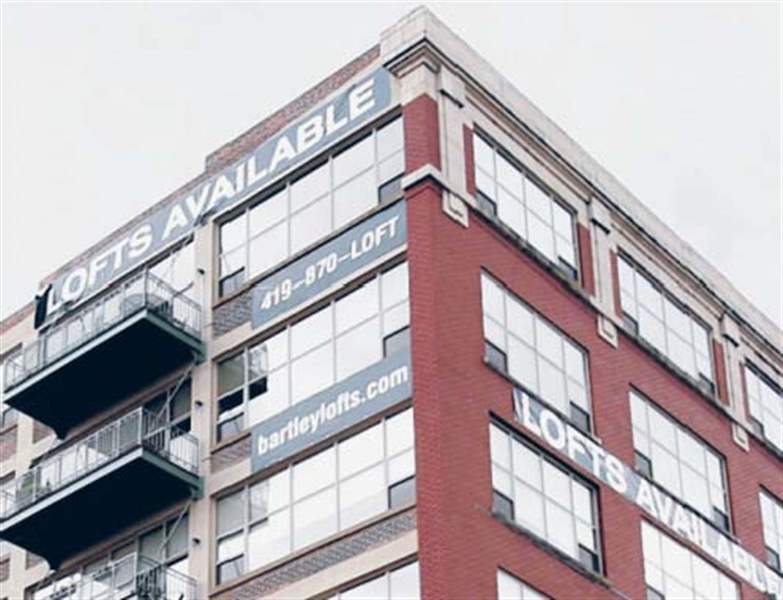
Almost half the 52-unit Bartley Lofts project is unsold nearly three years after completion. Condos have been viewed as a key component of downtown revitalization.

Fifth Third moved to One Seagate after Owens-Illinois left.
When glass-maker Owens-Illinois Inc. decamped for the suburbs two years ago, it set off a negative chain reaction in downtown Toledo's office and retail sectors.
Bellacino's Pizza & Grinders locked its doors for good. Ditto for nearby Quizno's Subs. Owners of the upscale Diva restaurant called it quits. And Ken's Flower Shop shut its downtown operation.
The losses were a buzz-kill for downtown boosters hopeful after the success of the community's minor-league ballpark, opening of new night spots and condos, and start on a new sports and entertainment arena.
"We have to recover again," laments downtown booster Bob Seyfang, who owns property in the city core and is involved in efforts to preserve the area's architecture.
But the situation in Toledo is not unique.
A quarter-century after traditional retailing died in the core of most cities, downtowns are facing another exodus.
READ MORE: Down But Not Out series
Since the beginning of the decade, six of Ohio's seven largest cities have experienced declines in businesses and private work forces downtown, U.S. Census Bureau reports show.
Nearly 700 companies and 40,000 jobs left downtowns and their environs in Toledo, Cincinnati, Cleveland, Columbus, Dayton, and Youngstown in the initial years of the decade, according to the bureau's ZIP code business patterns series.
The job losses come at a time of great promise - and tumult - in Ohio's large-city downtowns.
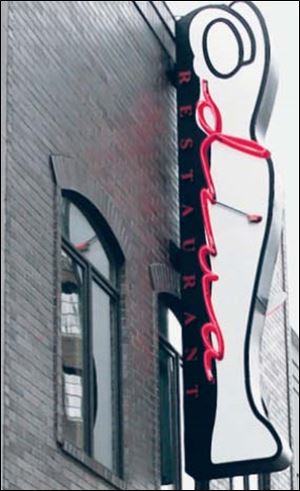
Several businesses near Fifth Third s previous downtown location closed after the move, including the upscale Diva restaurant.
Positive signs
From Toledo in the northwest to Dayton in the southwest, construction cranes are building arenas, corporate headquarters, and other structures.
Obsolete office buildings constructed before World War II are being converted to condos and lofts for young professionals and empty-nesters who are said to crave urban living.
New office towers are planned in Cleveland and Cincinnati.
Fresh bars and restaurants are bringing life to long-vacant retail sites.
Brightly clad "ambassadors" roam most large downtowns, picking up debris, giving directions, and confronting panhandlers as part of "clean-and-safe" teams duplicated across the state.
And downtown boosters say gas-pump prices exceeding $4 a gallon work in their favor because motorists are likely to begin moving from suburbs and exurbs to be closer to jobs and services in the city.
But downtown restoration efforts face serious obstacles.
Difficult times
The nation's mortgage crisis and home glut have put a crimp on condo and loft development, which has been viewed as a key component of the rescue.
Meanwhile, some downtown businesses report that customers have trimmed spending in response to gas price hikes.
Large department stores have disappeared in all cities but Cincinnati.
Cleveland and Columbus play host to boutiques and specialty shops. But stores are few in remaining cities.

Almost half the 52-unit Bartley Lofts project is unsold nearly three years after completion. Condos have been viewed as a key component of downtown revitalization.
In Toledo, O-I's move to Perrysburg from downtown in 2006 removed about 350 employees who helped keep cash registers chirping at restaurants and shops in the city core.
But the biggest impact came a year later when owners of the 32-story One Seagate, O-I's former home, persuaded Fifth Third Bank to move from its longtime offices at Madison Avenue and Huron Street. Several other tenants followed Fifth Third out of the office complex that dated from the early 20th century.
With less foot traffic, the struggling restaurants and flower shop - all in the Madison-Huron area - closed within a few months.
Decline in business
In other areas of the state, Dayton lost nearly 1,500 downtown jobs last year alone, officials say, after several companies left, including the former Mead Paper Co., which relocated offices to Virginia, and paper producer NewPage Corp. and engineering firm Woolpert Inc., which both moved jobs to the suburbs.
Dayton had the second-highest percentage of job losses between 2000 and 2005 among downtown special improvement districts, which are taxing authorities set up under Ohio law to collect taxes from businesses to promote the surrounding area. Ninety-two firms and 6,575 jobs, representing 26 percent of total downtown employment, left, according to a Census Bureau report last year.
Figures for 2006 will be released for major ZIP codes this year. The Census Bureau counted 913 firms with 18,411 employees in Dayton's downtown district.

But the census report counts only private employers, excluding public employees.
In Toledo, 58 firms and 2,227 employees, or 11 percent of the downtown work force, left the area surrounding the downtown special improvement district in the first half of the decade.
The Census Bureau counts 925 firms with 19,964 employees in the area, which includes portions of three ZIP codes.
Youngstown, in northeast Ohio, had the highest percentage losses, with downtown employment down 31 percent, or 1,622 workers, to 3,616. The number of businesses fell by 46, or 17 percent, to 219.
Cleveland, Columbus, and Cincinnati have far larger downtown work forces but still suffered losses in their downtown special improvement districts.
In Columbus, the number of businesses slipped by 60 to 2,700 and employment dropped by 12,003 to 62,761 from 2000 to 2005. Cleveland had 4,069 firms - a loss of 353 in five years - employing 115,941, which represented a decline of 5,681.
The Census Bureau didn't report precise figures for Cincinnati after 2003. But in the first three years of the decade, the city lost 100 businesses and 11,856 workers in the downtown area. As of 2003, Cincinnati had 2,215 firms with 72,433 employees.

The downtown losses equaled or surpassed overall county job declines, except for Cleveland, Census reports showed.
The only city showing employment growth in its downtown special improvement district in the first five years of the decade was Akron, south of Cleveland. Employment rose by 207, or 2 percent, to 12,871 in the primary ZIP code. The area had 492 businesses, or six fewer than in 2000.
But the district straddles two other ZIP Codes. Together, the three ZIPs include 939 firms with 25,954 employees. The figures reflect a tiny increase in the number of businesses and a 4 percent work force gain.
Disputed numbers
Officials in several cities took issue with the figures, saying they undercount downtown employment.
Sandy Gudorf, president of nonprofit Downtown Dayton Inc., noted that the report excludes public employees who iare a major component of that city's downtown work force. And, she added, downtown planners didn't include all neighborhoods of the city core when they drew up boundaries for the special improvement district.

In Cincinnati, the president of nonprofit Downtown Cincinnati Inc. said the ZIP code that includes that city's downtown special improvement district encompasses additional neighborhoods that aren't a good indicator of downtown employment.
And in Columbus, Ohio's capital, state workers - who aren't counted - represent a significant portion of the downtown work force.
Officials in Youngstown said employment has increased in that city's core by 300 this decade as a result of a pair of business incubators opened downtown to nurture firms involved in computer software design.
An upbeat outlook
The change in private employment in downtowns need not be fatal to revival efforts, boosters and researchers agree.
"Twenty-five years ago, everybody would say, 'It's about jobs, jobs, jobs,' " said John Gower, director of planning and community development in Dayton. "Today, we say, 'It's about jobs, amenities, and housing.' "
Eugenie Birch, an expert on downtowns who directs the Institute for Urban Research at the University of Pennsylvania in Philadelphia, isn't surprised that private work forces are declining.
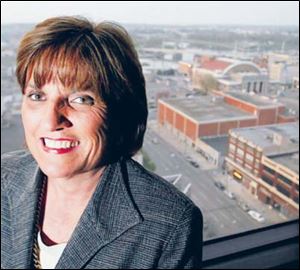
Sandy Gudorf, president of nonprofi t Downtown Dayton Inc., disputes the Census Bureau s figures. She says public employees should be counted in the number of downtown workers.
In part, she suspects, the figures reflect a trend that has been going on for some time. Many private employers have been replaced by what she calls "eds and meds" - universities and hospitals.
She predicted that, even if city cores have fewer employment opportunities, people will continue to buy homes and rent apartments there.
"It's an attraction if you can walk to work," she conceded. "But the decline of jobs is not going to be a deal-breaker. People will choose to live downtown if other things are happening that suits them."
Inducements include museums, lively restaurants, and other "fun places," she said.
Ms. Birch is the author of a 2005 report published by the nonprofit Brookings Institution which found that home ownership rates in downtowns more than doubled to 22 percent between 1970 and 2000 in 44 of the nation's biggest cities.
Housing woes
Among three Ohio cities included in the study, downtown ownership rates ranged from 10 percent in Columbus to 1 percent in Cincinnati, which the study's authors categorized as a "declining downtown."
But Cincinnati boosters insist that the southwest Ohio city has experienced major changes - including a rise in downtown residency - since the last census.
Cleveland, the only other Ohio city in the study, fared better, rating the highest classification of "emerging downtown."
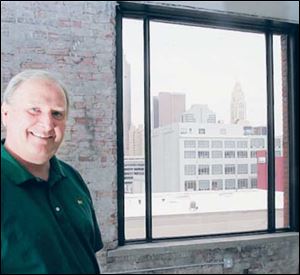
Jack Hoopes, a developer with Columbus Spectrum Properties, hopes the view of downtown Columbus from this empty CityView at 3rd condominium will attract a buyer.
Downtown housing has increased in most Ohio cities since 2000. More recently, the nation's real estate crash has put a chill on developments.
In Toledo, almost half the 52-unit Bartley Lofts project is unsold nearly three years after completion. Elsewhere, developer Jack Hoopes scored with two successful downtown projects in Columbus before his current venture, Cityview at 3rd. With half of the 48 units unsold, he doesn't plan new developments.
The good old days
Despite setbacks in Ohio's downtowns, people across the state display an attachment and nostalgia for the commercial and cultural hubs they recall from their youths.
"I remember when downtown was hustling and bustling," said Brenda Robinson, an Akron downtown worker, as she enjoyed her lunch hour from a bench at Lock 3 Park.
"We had O'Neil's and Polsky's Department stores. I'm sorry my kids - who are big now - didn't have the experience of enjoying a typical-town downtown."
Along with such sentiments, however, there is wide disagreement about how far downtown revival efforts have come and where they are headed.
Outside of special events, said Mrs. Robinson, downtown Akron "is almost like a ghost town."
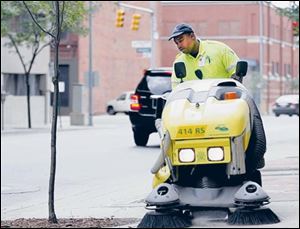
Vincent Davis, a Downtown Toledo Business Improvement District employee, sweeps a section of Huron Street as part of the agency s goal to keep downtown streets clean and safe.
"If you don't work downtown, most people don't come downtown," she continued.
But downtown boosters remain optimistic.
In Toledo, they point to successes such as Fifth Third Field, restoration of the Valentine Theatre, and construction of the $106 million multipurpose arena.
Even when businesses fail, new ones take their place, boosters point out. Speakeasy Lounge & Grill has taken the place of the former Jackson's on North Huron Street.
In Dayton, Don Chernick, 70, misses the shoulder-to-shoulder traffic found on downtown sidewalks in the 1950s and 1960s.
"I believe in downtown," said the longtime downtown jeweler. "Legitimate merchants are making a nice living here. Downtown is coming back fast."
Conceded Youngstown Mayor Jay Williams: "The poor national economy is definitely having an impact. But we've seen much worse and this city has been able to come back."
Contact Gary Pakulski at: gpakulski@theblade.com or 419-724-6082.